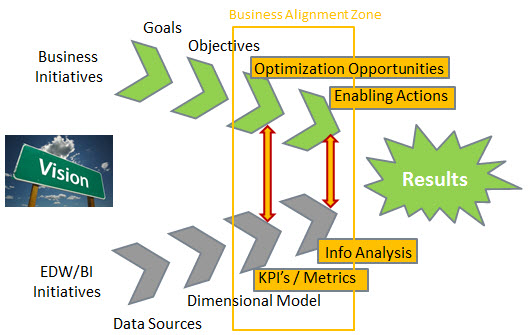Business analytics are the distillation of “big data” that is actually used to make decisions. Surprisingly, business analytics are rarely included in the data models used to build the EDW. More often, BI designers model analytics in the BI tool metadata, assuming that the EDW data model and physical structure will support those analytics. Surprises occur at this point! This project suggests best practices and tools for integrating business analytics into the EDW data modeling process to create better BI solutions.
What is a Business Analytics Data Model?
BI solutions typically involve many thousands of data objects. BI dimensional data modeling is often tasked to capture all “potentially useful” source elements for the target subject area. This largely source-driven approach can lead to a “boil the ocean” effort that delays the deployment of useful BI reporting. To enable a more direct path to BI results, business analytic objects are integrated with the BI dimensional model. The process is a convergence of source/target-driven and analytics-driven modeling.
A Business Analytic Data Model is an enriched form of the BI dimensional data model that includes analytic data objects. Analytic data objects directly influence manual or mechanized decision making, are predictive as well as historical in nature, and can be derived from structured and non-structured data.
Business analytics are the lynch-pins that unite business requirements analysis with data modeling. Data requirements emerge by decomposing the business analytics. Modeling from business analytics to the required data reveals gaps or structural problems in the data model that might be missed by traditional source-to-target BI dimensional data modeling. Each approach compliments the other in getting to the best solution in the shortest time.
What are the Goals of a Business Analytics Data Model?
Business analytics modeling can help solve three major BI/EDW challenges:
- Aligning business and IT stakeholders in the process of developing of BI/EDW solutions
- Ensuring that the EDW data model will support the business reporting requirements
- Establishing a framework for overall business performance management
On the surface, these challenges read like general requirements that would apply to any BI/EDW initiative. But why are they so incredibly difficult to achive? And how can a business analytics model help? Let’s address those questions one at a time.
Aligning Business and IT Stakeholders
IT and business stakeholders want the same thing in the end — a succesful BI solution that benefits the organziation and all involved. But they approach the journey from different perspectives.
There is a critical point where the business and IT journeys converge, and that is when the business analytics are formulated.
BUSINESS VIEW: Business analytics measure the optimization opportunity — How well are we doing? How big is the prize? Analytics suggest or trigger enabling actions to achive the opportunity.
IT VIEW: Business analytics are the nucleus of a mini-data model that collectively stretch into all corners of the dimensional model, and back to the data sources.
If we can get the IT and business collaboration right during this critical stage, the probablity of a successful BI/EDW result will be improved. Future posts will present some business analytics modeling methods, and pitfalls to avoid, gleaned from many BI projects undertaken by Brightlight and yours truly.
Ensuring that the EDW data model SUPPORTS business analytics reporting
<in process>
Establishing a framework for business performance management
<in process>
************
I would like your insights on business analytics modeling challenges you have encountered at your companies. Please use the comment form at the end of each post. I will respond and try to incorporate your ideas into the demonstration project.
